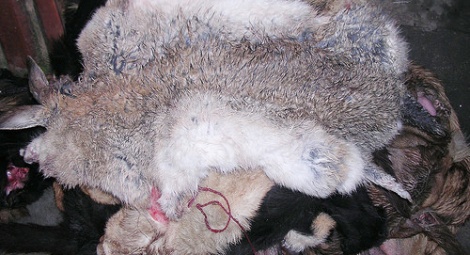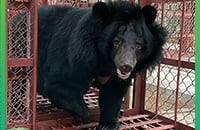FIVE things you NEED to know about fur
03 March 2015
Each year Hong Kong hosts the largest fur industry fair in the world.
Year by year Animals Asia and local animal lovers continue to protest.
For many activists the fight against fur reminds them of the very early days of protesting for animal rights. Sadly, while fur remains a no-go for any fashionista with a conscience, the trade still survives.
As this year’s event draws to a close, we bring you all you need to know about the fur trade in the 21st century.
1/The fur industry is animal carnage
Hundreds of millions of animals are killed annually for the fur trade. Mink, foxes, raccoon dogs, domestic dogs and cats, seals, bobcats, beavers and rabbits are killed in enormous numbers each year.
Today’s fur industry relies on factory farming. It is estimated that 85% of fur comes from animals intensively bred and reared. This means millions of animals leading torturous lives – all in the name of fashion.
2/ The feel of fur doesn’t reflect the suffering
Animals killed for their fur are slaughtered just after their first moult. At this time their first winter coats have emerged and so their fur will look to be in prime condition. Therefore, the way the fur looks and feels does not reflect the terrible conditions in which the animals have been reared.
3/ The fur trade is a global tragedy
China is now the biggest processor of fur products, while Europe and North America are major producers of raw fur.
The world’s largest producer of mink fur is Denmark, killing over 17 million animals a year. Other key mink fur producing countries such as Norway, Sweden, Finland, Iceland, the Netherlands, Russia, China and the US kill a combined 50 million mink every year.
4/ Fake fur fuels the trade
While faux fur may seem like an ethical alternative to products made from animal skin, the reality is that the wearing of fake fur contributes to demand for all fur products.
The acceptability of faux fur has led to many consumers, models and fashion designers returning to real fur since the low point of the industry in the 90s. The result, claims the British Fur Trade Association, is that sales of real-fur have increased by 71 per cent globally since then.
Also – while fur is claimed to be fake, there are widespread reports of a high percentage turning out to be the real thing – from rabbits and even cats and dogs.
5/ No country is fur free
As hard as it may seem to believe, not one country in the world has implemented a complete ban on the production and sale of fur. Countries such as the UK, Austria and Croatia have banned fur farming – but the import and sale of fur remains legal.
It wasn’t until 2011 that Oslo Fashion Week was widely claimed to be the first fur free fashion week after banning all fur from the runway.
Almost 500 designers, including the likes of Yves Saint Laurent, still use fur in their collections, while the 2015 New York Fashion Week featured fur products from Fendi and Gucci.
The slaughter of animals for their fur remains an enormous global industry which the International Fur Federation recently valued at over $40 billion – equal to the value of the global wi-fi industry.
However, many national and international retailers have stopped selling fur and joined the international Fur Free Retailer programme. If you oppose the industry, consider rewarding fashion outlets that do too.
BACK








 Freedom after two decades: Moon bears Nang and Mua rescued
Freedom after two decades: Moon bears Nang and Mua rescued
 With heavy hearts we say goodbye to our beloved Tulip
With heavy hearts we say goodbye to our beloved Tulip
 Three moon bears rescued from notorious bear bile farming hotspots in Vietnam
Three moon bears rescued from notorious bear bile farming hotspots in Vietnam